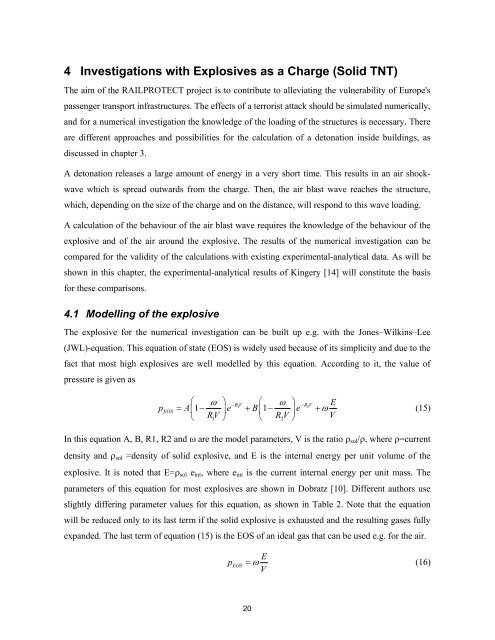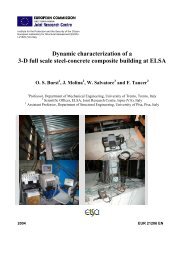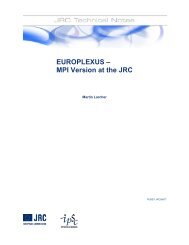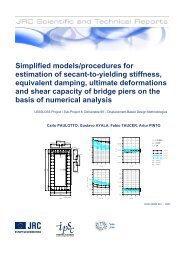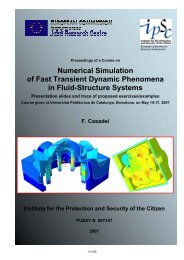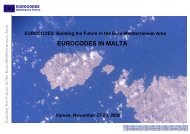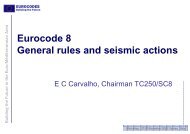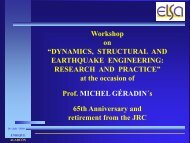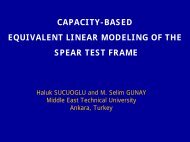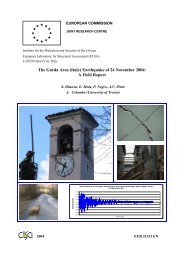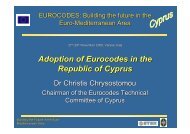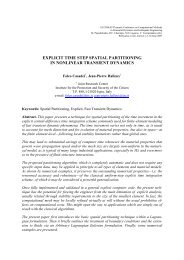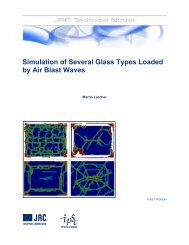Simulation of the Effects of an Air Blast Wave - ELSA - Europa
Simulation of the Effects of an Air Blast Wave - ELSA - Europa
Simulation of the Effects of an Air Blast Wave - ELSA - Europa
- No tags were found...
Create successful ePaper yourself
Turn your PDF publications into a flip-book with our unique Google optimized e-Paper software.
4 Investigations with Explosives as a Charge (Solid TNT)The aim <strong>of</strong> <strong>the</strong> RAILPROTECT project is to contribute to alleviating <strong>the</strong> vulnerability <strong>of</strong> Europe'spassenger tr<strong>an</strong>sport infrastructures. The effects <strong>of</strong> a terrorist attack should be simulated numerically,<strong>an</strong>d for a numerical investigation <strong>the</strong> knowledge <strong>of</strong> <strong>the</strong> loading <strong>of</strong> <strong>the</strong> structures is necessary. Thereare different approaches <strong>an</strong>d possibilities for <strong>the</strong> calculation <strong>of</strong> a detonation inside buildings, asdiscussed in chapter 3.A detonation releases a large amount <strong>of</strong> energy in a very short time. This results in <strong>an</strong> air shockwavewhich is spread outwards from <strong>the</strong> charge. Then, <strong>the</strong> air blast wave reaches <strong>the</strong> structure,which, depending on <strong>the</strong> size <strong>of</strong> <strong>the</strong> charge <strong>an</strong>d on <strong>the</strong> dist<strong>an</strong>ce, will respond to this wave loading.A calculation <strong>of</strong> <strong>the</strong> behaviour <strong>of</strong> <strong>the</strong> air blast wave requires <strong>the</strong> knowledge <strong>of</strong> <strong>the</strong> behaviour <strong>of</strong> <strong>the</strong>explosive <strong>an</strong>d <strong>of</strong> <strong>the</strong> air around <strong>the</strong> explosive. The results <strong>of</strong> <strong>the</strong> numerical investigation c<strong>an</strong> becompared for <strong>the</strong> validity <strong>of</strong> <strong>the</strong> calculations with existing experimental-<strong>an</strong>alytical data. As will beshown in this chapter, <strong>the</strong> experimental-<strong>an</strong>alytical results <strong>of</strong> Kingery [14] will constitute <strong>the</strong> basisfor <strong>the</strong>se comparisons.4.1 Modelling <strong>of</strong> <strong>the</strong> explosiveThe explosive for <strong>the</strong> numerical investigation c<strong>an</strong> be built up e.g. with <strong>the</strong> Jones–Wilkins–Lee(JWL)-equation. This equation <strong>of</strong> state (EOS) is widely used because <strong>of</strong> its simplicity <strong>an</strong>d due to <strong>the</strong>fact that most high explosives are well modelled by this equation. According to it, <strong>the</strong> value <strong>of</strong>pressure is given as⎛ ω ⎞−RV⎛ ω ⎞1 −R2VEpEOS= A⎜1− ⎟e + B⎜1− ⎟e+ ω⎝ RV1 ⎠ ⎝ RV2 ⎠ V(15)In this equation A, B, R1, R2 <strong>an</strong>d ω are <strong>the</strong> model parameters, V is <strong>the</strong> ratio ρ sol /ρ, where ρ=currentdensity <strong>an</strong>d ρ sol =density <strong>of</strong> solid explosive, <strong>an</strong>d E is <strong>the</strong> internal energy per unit volume <strong>of</strong> <strong>the</strong>explosive. It is noted that E=ρ sol e int , where e int is <strong>the</strong> current internal energy per unit mass. Theparameters <strong>of</strong> this equation for most explosives are shown in Dobratz [10]. Different authors useslightly differing parameter values for this equation, as shown in Table 2. Note that <strong>the</strong> equationwill be reduced only to its last term if <strong>the</strong> solid explosive is exhausted <strong>an</strong>d <strong>the</strong> resulting gases fullyexp<strong>an</strong>ded. The last term <strong>of</strong> equation (15) is <strong>the</strong> EOS <strong>of</strong> <strong>an</strong> ideal gas that c<strong>an</strong> be used e.g. for <strong>the</strong> air.pEOSE= ω (16)V20


